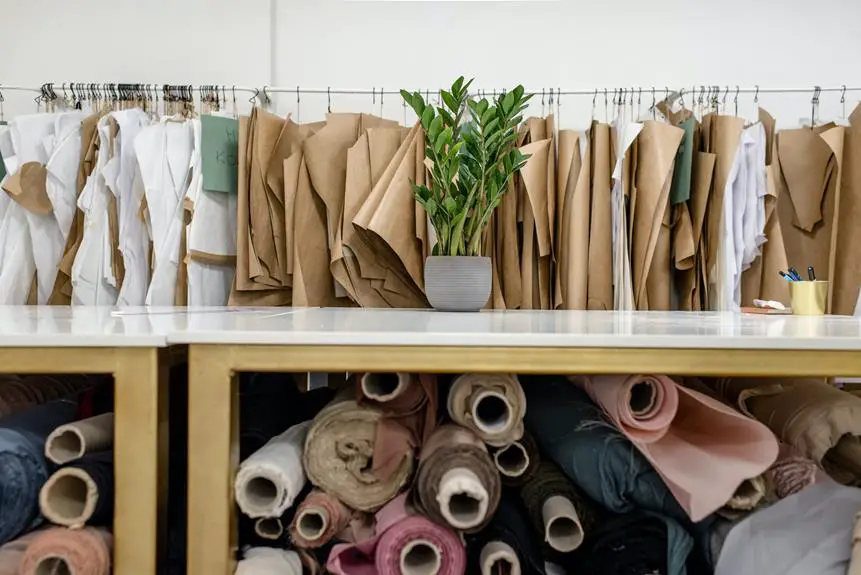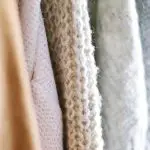Do you ever wonder what gives nonwoven fabrics their unique properties?
Nonwoven fabrics are made by bonding or interlocking fibers together, rather than weaving or knitting them. This results in a fabric that is strong, durable, and versatile. Understanding what nonwoven means in fabric will open up a world of possibilities for your projects.
Let's dive into the intricacies of nonwoven fabrics and explore their manufacturing process, characteristics, applications, advantages, and environmental impact. By the end, you'll have a comprehensive understanding of nonwoven fabrics and how they can be utilized in various industries.
Key Takeaways
- Nonwoven fabric is made by bonding or interlocking fibers together, rather than weaving or knitting them.
- Nonwoven fabrics are durable, breathable, and suitable for various applications.
- Sustainable production methods, such as renewable energy sources and closed-loop systems, can reduce the carbon footprint of nonwoven fabric manufacturing.
- Nonwoven materials have the potential to reduce waste through single-use applications and recycling into new products.
Definition of Nonwoven Fabric
Nonwoven fabric is a type of material made from fibers that are bonded together without being woven. There are various types of nonwoven fabrics, including felt, spunbond, meltblown, and needlepunched fabrics. Each type has its own unique characteristics and is suitable for different applications.
Nonwoven fabrics offer several benefits. They're cost-effective to produce, as the manufacturing process is generally faster and requires less material compared to traditional woven fabrics. Nonwoven fabrics are also versatile and can be engineered for specific purposes, such as providing strength, absorbency, liquid repellency, softness, or cushioning. Additionally, nonwoven fabrics are often considered more environmentally friendly than woven fabrics, as they can be made from recycled materials and are recyclable themselves.
Nonwoven fabrics are used in a wide range of industries, including healthcare, agriculture, automotive, construction, and more. The unique properties of nonwoven fabrics make them suitable for diverse applications, such as medical masks, agricultural covers, automotive upholstery, and geotextiles for soil stabilization.
Manufacturing Process of Nonwoven Fabrics
When manufacturing nonwoven fabrics, fibers are bonded together without being woven using a variety of processes. This allows for the creation of fabrics with diverse properties and applications. Here are three key production techniques used in the manufacturing process of nonwoven fabrics:
- Mechanical Bonding: In this technique, fibers are entangled using mechanical methods such as needle punching or hydroentanglement. Needle punching involves punching barbed needles through the web of fibers, entangling them and creating a cohesive fabric. Hydroentanglement, on the other hand, uses high-pressure water jets to entangle the fibers, resulting in a fabric with good strength and softness.
- Chemical Bonding: Chemicals are used to bond the fibers together in this method. A bonding agent is applied to the web of fibers, which is then cured, causing the fibers to adhere to each other. This technique allows for the production of nonwoven fabrics with specific characteristics such as flame resistance or water repellence.
- Thermal Bonding: Thermal bonding involves using heat to melt thermoplastic fibers within the fabric, causing them to bond together. This process results in nonwoven fabrics with good dimensional stability and strength.
These production techniques showcase the versatility and innovation involved in creating nonwoven fabrics through fiber bonding.
Characteristics of Nonwoven Materials
Nonwoven materials exhibit diverse properties that make them suitable for various applications in different industries. One key characteristic of nonwoven materials is their durability. They're engineered to withstand wear and tear, making them ideal for products that require long-term use, such as upholstery, geotextiles, and medical supplies. The structure of nonwoven fabrics contributes to their strength and resilience, allowing them to maintain their integrity even under harsh conditions.
Another important characteristic is breathability. Nonwoven materials can be designed to allow air and moisture to pass through, making them suitable for applications where breathability is essential, such as in hygiene products, protective clothing, and filtration systems. This property ensures comfort for the end user and allows for the efficient transfer of moisture and heat, making nonwoven materials versatile in a wide range of environments.
Applications of Nonwoven Fabrics
Nonwoven fabrics have a wide range of applications across various industries, making them incredibly versatile.
Their sustainable production methods also contribute to their increasing popularity in today's environmentally conscious world.
Let's explore how these fabrics are being used and why they're becoming a preferred choice in many sectors.
Versatility in Various Industries
You can find nonwoven fabrics being used in a wide range of industries due to their versatility and unique properties. The innovative uses of nonwoven fabrics make them indispensable in various applications, including:
- Medical Industry: Nonwoven fabrics are used in surgical gowns, masks, and drapes due to their breathability, liquid resistance, and barrier properties, ensuring the safety of healthcare professionals and patients.
- Automotive Sector: Nonwoven fabrics are employed for interior trims, carpets, and insulation due to their sound absorption, durability, and moldability, enhancing the comfort and safety of vehicle occupants.
- Agricultural Field: Nonwoven fabrics are utilized in crop covers, weed control barriers, and plant protection due to their permeability, strength, and UV resistance, contributing to improved crop quality and yield.
The versatility of nonwoven fabrics continues to drive their adoption in diverse industrial sectors, showcasing their adaptability and performance.
Sustainable Production Methods
Sustainable production methods for nonwoven fabrics encompass environmentally friendly processes that minimize resource consumption and waste generation. Eco-friendly production techniques and resource-efficient methods are essential for reducing the environmental impact of fabric production. Utilizing renewable energy sources, such as solar or wind power, can significantly decrease the carbon footprint of nonwoven fabric manufacturing. Additionally, implementing closed-loop systems for water usage and recycling of materials can further enhance the sustainability of production processes. By prioritizing the use of biodegradable and recyclable raw materials, nonwoven fabric manufacturers can contribute to a more sustainable industry. Here's an example of resource-efficient techniques in nonwoven fabric production:
| Resource Efficient Techniques | Benefits | Implementation |
|---|---|---|
| Renewable Energy Sources | Reduced carbon footprint | Solar or wind power usage |
| Closed-loop Systems | Minimized water usage and waste | Recycling and reusing water and materials |
| Biodegradable Raw Materials | Environmentally friendly end products | Prioritizing natural and biodegradable materials |
Advantages of Nonwoven Fabrics
An advantage of nonwoven fabrics is their versatility in various applications, making them a practical choice for a wide range of uses. These fabrics possess unique characteristics that set them apart from traditional woven or knitted textiles.
Here are three key advantages of nonwoven fabrics:
- Diverse Applications: Nonwoven fabrics are utilized in a wide array of industries, including healthcare, automotive, construction, and agriculture. They're used in products such as medical masks, automotive upholstery, geotextiles, and crop covers due to their adaptability and strength.
- Ease of Manufacturing: The production of nonwoven fabrics is efficient and cost-effective. The manufacturing process involves consolidating fibers using various techniques like needle punching, spunbonding, or melt blowing, resulting in a fabric with distinct properties such as breathability, durability, and absorbency.
- Sustainability Impact: Nonwoven fabrics can be engineered from recycled materials, making them a sustainable choice. Their lightweight nature reduces transportation costs and energy consumption, contributing to environmental conservation efforts.
These advantages make nonwoven fabrics an attractive option for a multitude of practical and sustainable applications.
Environmental Impact of Nonwoven Materials
The environmental impact of nonwoven materials extends beyond their sustainability, encompassing their end-of-life disposal and potential for recycling. Nonwoven materials can offer environmental sustainability benefits by reducing waste.
Unlike traditional woven fabrics, nonwovens can be designed for single-use applications, reducing the need for laundering and water consumption. Additionally, nonwovens can be engineered to be biodegradable or compostable, further minimizing their impact on the environment.
When considering waste reduction, nonwoven materials have the potential to decrease the amount of textile waste ending up in landfills. However, it's important to note that not all nonwovens are biodegradable or compostable, and proper disposal methods should be followed to minimize their environmental impact.
Recycling of nonwoven materials is also an area of growing interest. Some nonwovens can be recycled into new products, contributing to a circular economy and reducing the consumption of virgin resources. As the demand for environmentally sustainable materials grows, advancements in the recycling of nonwoven materials are likely to play a significant role in reducing the overall environmental impact of the textile industry.
Frequently Asked Questions
Can Nonwoven Fabrics Be Recycled or Composted at the End of Their Life Cycle?
Yes, nonwoven fabrics can be recycled and composted at the end of their life cycle, reducing their environmental impact. Recycling and composting offer sustainable end-of-life management options for nonwoven fabrics.
Are There Any Specific Care Instructions for Nonwoven Fabrics, Such as Washing or Ironing?
For nonwoven fabrics, follow specific washing instructions to maintain quality. Use mild detergent and cold water for gentle cleaning. Avoid using bleach or fabric softeners. Iron on low heat with a cloth layer between fabric and iron.
How Do Nonwoven Fabrics Compare to Traditional Woven or Knitted Fabrics in Terms of Durability and Longevity?
In terms of durability and longevity, nonwoven fabrics have a strong edge over traditional woven or knitted fabrics. They can withstand wear and tear, making them a sustainable choice with a lower environmental impact.
What Are Some Common Misconceptions About Nonwoven Fabrics That You Often Encounter?
Common misconceptions about nonwoven fabrics include confusion about their characteristics, recycling, composting, and care instructions. Despite these misconceptions, emerging technologies and innovations have improved their durability and sustainability, challenging traditional fabric perceptions.
Are There Any Emerging Technologies or Innovations in the Nonwoven Fabric Industry That Consumers Should Be Aware Of?
You should be aware of emerging technologies and sustainable practices in the nonwoven fabric industry. Innovations like biodegradable nonwovens and advanced recycling processes are changing the landscape, offering more eco-friendly options for consumers.
- PETA and Angora: Understanding the Campaign Against the Fiber - July 2, 2025
- What Is “Hand-Plucked” Angora and Is It Really Humane? - July 2, 2025
- A Consumer’s Guide to the Angora Ethics Debate - July 2, 2025






